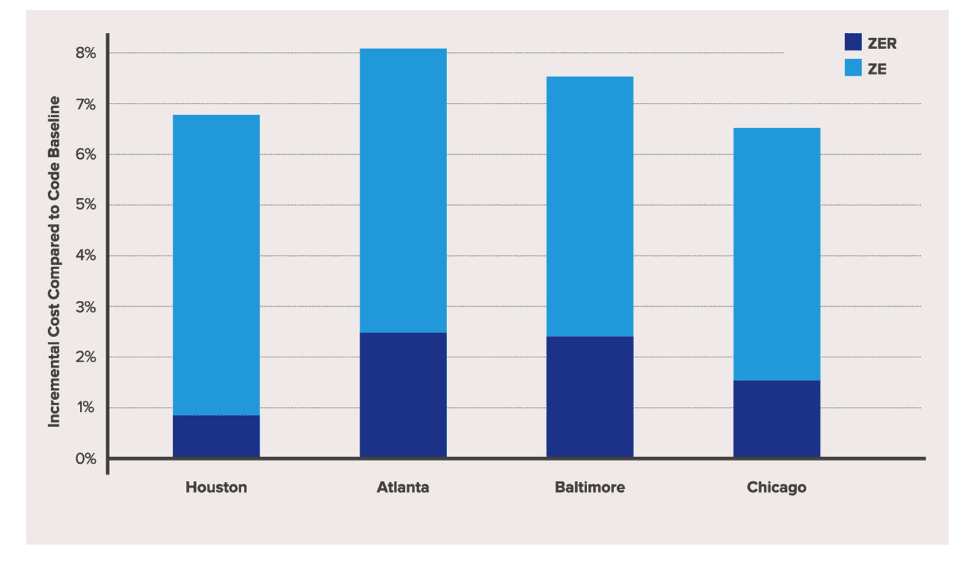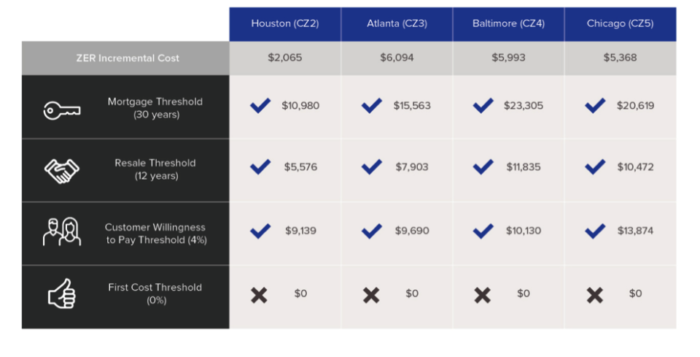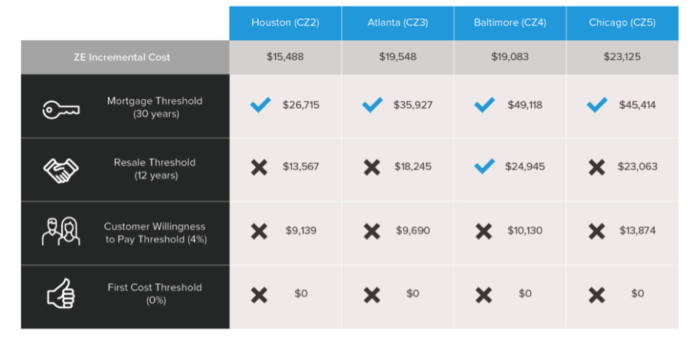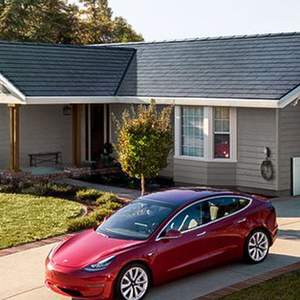
Zero-energy (ZE) homes — efficient homes that produce or procure as much renewable energy as they consume over the course of a year — are often marketed as luxury homes, only available to the select few who are willing to pay a significant premium to do the right thing for the environment. In keeping with this luxury perception, research shows these homes are often more comfortable and healthier than conventional homes for a variety of reasons. Mainstream media outlets have suggested cost premiums as high as 40% for sustainable real estate.
However, the economics for these homes have changed: ZE homes have quietly passed cost thresholds that make them not only good for the environment but also cost-effective. As the underlying technologies and design elements continue to improve and scale, these costs will continue to decline.
Rocky Mountain Institute (RMI) recently released Economics of Zero-Energy Homes: Single Family Insights. Our work aimed to address the perceived cost of ZE and zero-energy ready (ZER) homes — homes designed to achieve ZE levels of efficiency but that don’t yet have photovoltaics (PV). The report also provides both home builders and policymakers with guidance on how to bring these homes to market.
Here’s what we learned:
Insight #1: ZE homes already approach cost parity
Contrary to popular belief, ZER homes fall under a 3% incremental cost in most parts of the country, with that cost dropping under 1% in select locations such as Houston, Texas. Developers may even be able to construct these homes at cost parity in locations with stricter baseline codes (our analysis assumed construction meeting the 2009 International Energy Conservation Code) and aggressive incentive offerings from local utilities (which we did not consider in our work). The solar panels necessary to bring those ZER homes to ZE bring the incremental cost to 7% to 8%; however, a wide array of solar financing options can be used to cover part or all of that additional cost.

Insight #2: ZE homes meet certain cost thresholds
Savvy consumers consider upfront and ongoing costs in a variety of everyday purchasing decisions. Although research shows that consumers often apply a much higher discount rate than businesses or financial institutions do, consumers still consider ongoing savings and are willing to pay a premium for these savings.
Many consumers consider ongoing cost savings as they look to purchase a home. In an effort to understand how the cost and value of ZE and ZER homes would stand up to this decision-making process, RMI compared the incremental upfront cost of these homes against four “cost thresholds” defined below:
- Mortgage threshold: The anticipated energy cost savings over the life of the mortgage.
- Resale threshold: The anticipated energy cost savings over 12 years (the average duration homeowners expect to stay in a home).
- Consumer willingness to pay threshold: The 4% first cost premium customers have stated they’re willing to pay according to consumer research.
- First cost threshold: Zero incremental cost compared with an identical code-compliant home.
When the incremental cost of building ZE and ZER homes falls below these cost thresholds, savvy homebuyers are more likely to bear the cost of investment in ZE or ZER homes. For example, if the cost of upgrading a home to ZE is less than the cost of energy the homeowner pays over 12 years in a standard non-ZE home, then a homeowner using the resale cost threshold would be more likely to purchase the home. In many cases, these cost thresholds have already been achieved in local markets.


Insight #3: Not all ZE homes are created equal
RMI’s analysis considered hundreds of different energy measure combinations to identify the lowest cost pathway to net-zero design in four different climate zones.
Although our analysis yielded concrete recommendations for cost-optimal ZE home designs, a variety of other solutions are available and may be specified based on local conditions or consumer priorities. The most interesting takeaway was that in the climate zones we analyzed (IECC 2–5), ZE and ZER levels of efficiency could be achieved without aggressive or cutting-edge envelope and HVAC solutions.
Although these solutions may yield other benefits such as thermal comfort or passive resilience, from a strict cost standpoint, removing these leading-edge solutions from the ZE package resulted in a significantly lower cost premium.
In all climates, the cost optimal solution from RMI’s analysis included 100% LED lighting, low-flow water fixtures, and Energy Star appliances, all of which reduce load at a very minimal cost premium. In addition, heat pumps were used for both space heating and water heating. The roof, walls, and windows were efficient but did not exceed the DOE Zero Energy Ready Home (ZERH) prescriptive efficiency levels. Although there is no one-size-fits-all cost-optimal solution to building ZE homes, our analysis indicated that these energy measures are cost-effective in almost any situation.
We consider this analysis to be conservative, as we have a limited ability to consider integrative design approaches or opportunities unique to a specific homesite such as ground source heat pumps. We similarly do not consider district heating or cooling options to which some districts might have access. Similarly, we do not consider additional premium elements that today correlate with net-zero energy design (e.g., nicer appliances or finishes). We consider this analysis to be a baseline premium for a ZE or ZER home, with the opportunity to increase the performance, decrease the cost, or increase the value through custom or site-specific design elements.
Insight #4: Costs will continue to decline
Although the results of this report show that constructing ZE homes can be economical for most homeowners in most locations today, it’s important to understand how costs are expected to change in the future. Industry progress and demand for super-efficient building components is expected to drive cost savings over the next decade. Specifically, our projected cost decline is a result of PV costs dropping, reduced PV system size requirements (due to equipment efficiency gains), and efficient equipment becoming more mainstream.
These factors should bring ZE homes in the four locations modeled within a 3% to 5% incremental cost by 2030, compared with a 6% to 8% incremental cost today. The opportunity for cost savings in ZER homes is less significant, with incremental costs projected to drop roughly 20% by 2030.
Builders should reevaluate their ZE solution every few years to ensure it is still cost optimal with dropping solar prices and improving technology.
Call to action
ZE and ZER homes are still a niche product, currently representing less than a 1.4% market share of new construction. However, given the promising results of RMI’s analysis, the proliferation of homes certified through the DOE ZERH program, and California’s recently adopted requirement that all new homes be ZE by 2020, it is clear that this market is at a tipping point.
RMI, DOE, and a host of other organizations are working with city policymakers and real estate developers to meet the call of this impending market transformation. Through our collective action, we can address an essential piece of our carbon footprint while unlocking the variety of benefits that ZE and ZER homes provide. ZE and ZER homes are market ready, and it is time to act!
Alisa Petersen and Michael Gartman are both senior associates on Rocky Mountain Institute’s Buildings team. ©2018 Rocky Mountain Institute. Published with permission. Originally posted at RMI Outlet.
Weekly Newsletter
Get building science and energy efficiency advice, plus special offers, in your inbox.















9 Comments
We just took possession of our net Zero home, certified under the CHBA ( Canadian home builders association). We went fancier than we had to, strictly speaking, by upgrading the HVAC to a Mitsubishi hyper heat unit, and oversized the solar array to be able to also offset the electric car usage.
Total incremental costs were around 70k on a 650k house. 16k of that was incremental mechanical cost, 30k was for the solar array, 18k for building envelope improvements, and upgraded basement insulation.
We're definitely below the mortgage threshold, but we're couldn't convince our lender that there is no heating bill... Nor did they have the ability to mark primary heating system as being a heat pump.
Overall, we're very happy with the results.
Lender and code-official education on cold climate heat pump performance had long been a nagging issue in my area too, but that seems to be changing in recent years, but it still draws questions. What, there's no backup? You NEED backup heat for a heat pump! (At least according to some code enforcement, until they're shown the Manual-J and the extended temperature capacity tables.)
Regarding the zero heating bill, I'd think an oversized PV array and all electric heating would be straight arithmetic for lenders to follow though. How was that resolved (or was it)?
It wasn't resolved because the financing wasn't an issue.
The problem was that the program treated a zero heating bill as not having been entered yet. The minimum we could have was $60 / year, so we just went with that...
Close enough for our purposes.
.
You guys don't have exclusivity on the lack of education in your area up-nawth!... nor its just for lenders and building officials alone. I've said for many years that our whole building industry, including builders, trades, raters, real estate agents, etc., is not the most "education forward" of many industries that consider it selves Professionals.
When I teach classes for the ZERH program, I always get the same 30-40 people, out of thousands of individuals in the DFW metroplex or States, that always come to any type of presentation, mine or some one else, free or not. To add, in many States like TX, there is no licensing or education requirements for builders and some trades, so anyone with a pickup truck, a hammer and a cell phone can be in business. There is also no pride in any of the building professionals anymore, as most want to do the cheapest, crappiest and quickest job while screwing their clients.
Unfortunately, States and local municipalities don't care, don't have the money, and/or rather protect "tax receivables" from the industry than protect their citizens.
That's why we went with a builder advertising net Zero home construction... He had the right trades people to take our vision and add brick and mortar as appropriate... :)
As one of those as you describe builders here in Texas I am trying to change. In particular how can I make a affordable home that is energy efficient with solar for a small development? Trying to address many of the issues in the design of the home. Gonna have to take some chances since my team is small and eager.
My advice to all Builders I work with, or come to my classes, is that all starts with you, the Builder. You have to be 150% in it. Hire the right team, an experienced team. If you get anyone telling you “but I’ve been doing it my way for 30 years”, it’s time to get someone else.
It also begins with a good detailed set of plans and specifications. If you allow the inexperienced trades to dictate the way you build, you lost the battle before you even start. Plan to overhaul your ways if necessary.
Start every job with your end-goals in writing, on your specs... that way all the trades get to read them:
1. Zero Energy Ready Homes
2. 1ACH50
3. HERS 40s
4. 1 ton of AC per 1,500 sf
5. Good indoor air quality (IAQ)
To achieve all those goals, you’ll have to deal with a good building envelope, properly designed framing, HVAC, plumbing and electrical systems. Know the right material for the right application with the correct installation. Know the Code too.
This is not that hard, everyone of my clients have achieve those goals on their first try; as I said, is all about your commitment!
As far as cost, read the following blog from last Monday: https://www.greenbuildingadvisor.com/article/zero-energy-homes-ready-mainstream
“[Deleted]”
It would be significantly helpful to have local municipalities that actually enforce air tightness and insulation requirements during inspections. I encounter trepidation and resistance from almost every link in the chain - financing, development, local municipalities, professional architecture and engineering, contracting, and clients. Much of this resistance just means I need to do a better job of communicating the value and rational of building better for the present and future. But the municipal regulatory inspection side, that's one of the hardest and realest to deal with in my book.
Log in or create an account to post a comment.
Sign up Log in